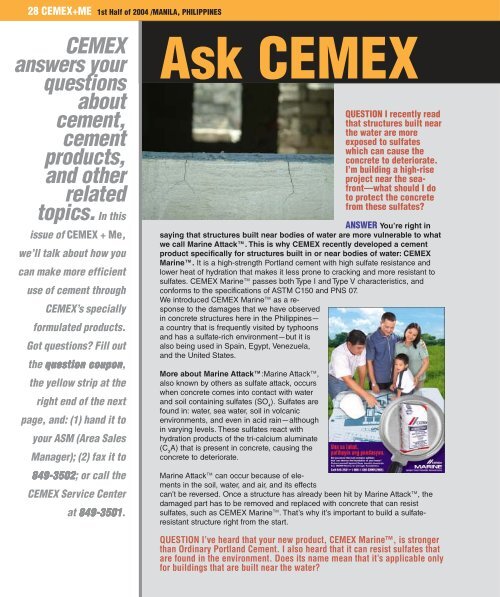AAA CEMEXME v 13 for press.pmd - Cemex Philippines
AAA CEMEXME v 13 for press.pmd - Cemex Philippines
AAA CEMEXME v 13 for press.pmd - Cemex Philippines
You also want an ePaper? Increase the reach of your titles
YUMPU automatically turns print PDFs into web optimized ePapers that Google loves.
28 CEMEX+ME 1st Half of 2004 /MANILA, PHILIPPINES<br />
CEMEX<br />
answers your<br />
questions<br />
about<br />
cement,<br />
cement<br />
products,<br />
and other<br />
related<br />
topics. In this<br />
issue of CEMEX + Me,<br />
we’ll talk about how you<br />
can make more efficient<br />
use of cement through<br />
CEMEX’s specially<br />
<strong>for</strong>mulated products.<br />
Got questions? Fill out<br />
the question question question question question coupon coupon coupon, coupon coupon<br />
the yellow strip at the<br />
right end of the next<br />
page, and: (1) hand it to<br />
your ASM (Area Sales<br />
Manager); (2) fax it to<br />
849-3502 849-3502 849-3502; 849-3502 849-3502 or call the<br />
CEMEX Service Center<br />
at 849-3501. 849-3501 849-3501 849-3501 849-3501<br />
Ask CEMEX<br />
QUESTION I recently read<br />
that structures built near<br />
the water are more<br />
exposed to sulfates<br />
which can cause the<br />
concrete to deteriorate.<br />
I’m building a high-rise<br />
project near the seafront—what<br />
should I do<br />
to protect the concrete<br />
from these sulfates?<br />
ANSWER You’re right in<br />
saying that structures built near bodies of water are more vulnerable to what<br />
we call Marine Attack. This is why CEMEX recently developed a cement<br />
product specifically <strong>for</strong> structures built in or near bodies of water: CEMEX<br />
Marine. It is a high-strength Portland cement with high sulfate resistance and<br />
lower heat of hydration that makes it less prone to cracking and more resistant to<br />
sulfates. CEMEX Marine passes both Type I and Type V characteristics, and<br />
con<strong>for</strong>ms to the specifications of ASTM C150 and PNS 07.<br />
We introduced CEMEX Marine as a response<br />
to the damages that we have observed<br />
in concrete structures here in the <strong>Philippines</strong>—<br />
a country that is frequently visited by typhoons<br />
and has a sulfate-rich environment—but it is<br />
also being used in Spain, Egypt, Venezuela,<br />
and the United States.<br />
More about Marine Attack:Marine Attack,<br />
also known by others as sulfate attack, occurs<br />
when concrete comes into contact with water<br />
and soil containing sulfates (SO 4 ). Sulfates are<br />
found in: water, sea water, soil in volcanic<br />
environments, and even in acid rain—although<br />
in varying levels. These sulfates react with<br />
hydration products of the tri-calcium aluminate<br />
(C 3 A) that is present in concrete, causing the<br />
concrete to deteriorate.<br />
Marine Attack can occur because of elements<br />
in the soil, water, and air, and its effects<br />
can’t be reversed. Once a structure has already been hit by Marine Attack, the<br />
damaged part has to be removed and replaced with concrete that can resist<br />
sulfates, such as CEMEX Marine. That’s why it’s important to build a sulfateresistant<br />
structure right from the start.<br />
QUESTION I’ve heard that your new product, CEMEX Marine, is stronger<br />
than Ordinary Portland Cement. I also heard that it can resist sulfates that<br />
are found in the environment. Does its name mean that it’s applicable only<br />
<strong>for</strong> buildings that are built near the water?


